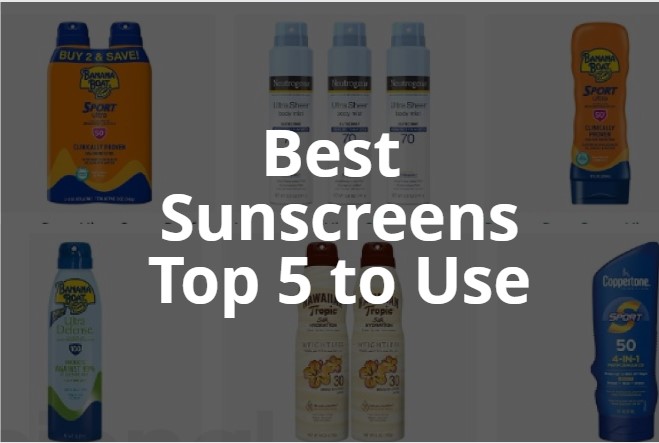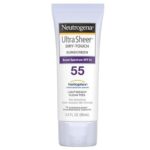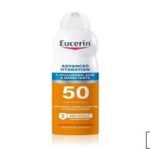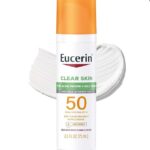Sunscreens for Maximum Skin Safety, What sunscreen ingredients to avoid

The Best Sunscreens are essential for maximum skin safety, especially as we become more aware of the harmful effects of sun exposure. In this comprehensive guide, we delve into the world of sun protection, highlighting the top sunscreens that offer the best defense against harmful UV rays. We also shed light on key ingredients to avoid in sunscreens, ensuring you make informed choices for your skin’s health. From understanding SPF ratings to identifying skin-friendly formulations, our expert insights will equip you with the knowledge to choose the best sun protection for your needs. Join us as we explore the most effective and safe sunscreens for 2024. 6 Must-Have Travel Makeup Organizers for Jet-Set Beauties
We all know the importance of taking care of our skin, especially when it comes to protecting it from the harmful effects of the sun. But do you ever find yourself overwhelmed with the countless options of sunscreens available? Well, worry no more! In this blog post, we will explore the ingredients you should avoid in sunscreens for maximum skin safety. Because let’s face it, when it comes to our skin, we deserve only the best. So, get ready to discover the key to keeping your skin safe, healthy, and glowing all summer long. Let’s dive in!
Table of Contents
Why ingredient selection is important in sunscreens
Sunscreen is an essential part of our skincare routine, protecting our skin from the harmful effects of the sun’s rays. However, not all sunscreens are created equal. The ingredients used in sunscreens can have a significant impact on both their effectiveness and safety. Understanding why ingredient selection is important will empower you to make informed decisions and ensure your skin is properly protected.
1. Effectiveness of Protection
When it comes to sunscreens, the effectiveness of protection is of utmost importance. The right ingredients can provide a higher level of protection against both UVA and UVB rays, reducing the risk of sunburn, premature aging, and skin cancer. Here are a few key ingredients to look for:
- Zinc oxide and titanium dioxide: These mineral-based ingredients form a physical barrier on the skin, reflecting and scattering UV rays away from the skin’s surface.
- Avobenzone and Mexoryl SX: These organic compounds absorb UVA rays and prevent them from penetrating the deeper layers of the skin.
2. Broad-Spectrum Protection
While sunscreens may protect against one type of UV radiation, such as UVB, it is essential to choose products that offer broad-spectrum protection. This means that the sunscreen protects against both UVA and UVB rays. Look for the words “broad-spectrum” on the product label to ensure comprehensive protection.
3. Avoiding Harmful Chemicals
Ingredient selection is crucial to avoiding potentially harmful chemicals in sunscreens. Some sunscreen ingredients have been found to cause irritation, allergic reactions, or disrupt hormone function. Here are a few ingredients to be cautious of:
- Oxybenzone: This common chemical ingredient can cause skin irritation and has been linked to hormone disruption.
- Octinoxate: Another chemical compound that can lead to skin allergies and hormone disruption.
- Parabens: These preservatives have raised concerns for their ability to mimic estrogen in the body.
Choose sunscreens that are labeled “hypoallergenic” or “chemical-free” to ensure a safer option for your skin.
4. Environmental Impact
It’s not just our skin that can be affected by the ingredients in sunscreens; the environment can also suffer. Some sunscreen ingredients, such as oxybenzone and octinoxate, have been found to cause damage to coral reefs and other marine life. To protect both your skin and the environment, opt for sunscreens that are reef-safe or formulated with eco-friendly ingredients.
Common harmful ingredients in sunscreens
Sunscreen is an essential part of our skincare routine, protecting our skin from the harmful effects of the sun’s ultraviolet (UV) rays. However, not all sunscreens are created equal. Many widely available sunscreens contain harmful ingredients that can do more harm than good. In this blog section, we will discuss some of the most common harmful ingredients found in sunscreens and their potential side effects. By understanding these ingredients, you can make informed choices to safeguard your skin and overall health.
1. Chemical Filters: Oxybenzone, Octinoxate, and Avobenzone
Chemical filters, such as oxybenzone, octinoxate, and avobenzone, are commonly used in sunscreens due to their ability to absorb UV rays. However, these chemicals have raised concerns due to their potential health and environmental risks:
- Oxybenzone and octinoxate have been linked to hormonal disruption, causing imbalances that can lead to reproductive issues and developmental delays.
- Avobenzone, though generally considered safe for use, can break down under UV light, leading to skin irritation and potential free radical damage.
To protect yourself from these harmful ingredients, look for sunscreens that use mineral filters like zinc oxide or titanium dioxide instead. These ingredients provide effective and safer protection against UV rays without the potential health risks associated with chemical filters.
2. Preservatives: Parabens and Phenoxyethanol
Preservatives are used in sunscreens to extend their shelf life and prevent the growth of bacteria or mold. Two common preservatives found in sunscreens are parabens and phenoxyethanol. However, these preservatives have come under scrutiny for several reasons:
- Parabens, such as methylparaben and butylparaben, have been linked to hormone disruption and are believed to mimic the effects of estrogen in the body, potentially increasing the risk of breast cancer.
- Phenoxyethanol, although considered safe at low concentrations, can cause skin irritation and allergic reactions in some individuals.
To avoid preservatives that may be harmful to your health, opt for sunscreens labeled “paraben-free” or “phenoxyethanol-free.” There are many brands available that prioritize using natural preservatives or alternative methods to ensure product safety without compromising your well-being.
3. Fragrances: Hidden Dangers
Fragrances are added to sunscreens to enhance their sensory appeal. However, many fragrances are composed of a mixture of chemicals, some of which can cause skin irritations, allergies, or even hormonal disruptions. It’s important to note that companies are not legally required to disclose the specific ingredients used in their fragrances, leading to potential hidden dangers.
To avoid unnecessary risks, choose sunscreens that are labeled “fragrance-free” or “unscented.” These products may still contain minimal fragrance to mask the scent of other ingredients, but they are less likely to trigger adverse reactions in sensitive individuals.
4. Nanoparticles: Minimizing Health Concerns
Nanoparticles, such as micronized zinc oxide or titanium dioxide, are used in some sunscreens to reduce the white cast that mineral filters can create on the skin. While these particles are generally considered safe, concerns have been raised about their potential to penetrate the skin and cause cellular damage.
To minimize potential health concerns, look for sunscreens that use non-nano particles or those that have undergone surface modification. These modifications enhance the particle’s ability to stay on the skin’s surface, providing effective protection without compromising your skin’s health.
Potential Risks Associated with Harmful Ingredients
1. Skin Irritation and Allergic Reactions
Some ingredients commonly found in sunscreens, such as oxybenzone and fragrances, can cause skin irritation and allergic reactions. This can lead to redness, itching, and even more severe symptoms like swelling and hives. People with sensitive skin are particularly susceptible to these risks.
Example:
- Brand A’s sunscreen contains oxybenzone, and some users have reported experiencing redness and itching after applying it.
2. Hormone Disruption
Certain sunscreen ingredients, like oxybenzone and octinoxate, have been found to have hormone-disrupting properties. When absorbed into the body, they may mimic or interfere with hormones, such as estrogen, leading to potential hormonal imbalances.
Example:
- The chemical filters used in Brand B’s sunscreen, including oxybenzone and octinoxate, have raised concerns about potential hormone disruption effects in laboratory studies.
3. Environmental Impact
Some ingredients commonly found in sunscreens, such as oxybenzone and octinoxate, can have harmful effects on aquatic ecosystems. When we swim in the ocean or other bodies of water, these ingredients can wash off our bodies and harm coral reefs, marine life, and other aquatic organisms.
Example:
- Research has shown that the presence of oxybenzone and octinoxate in sunscreens has been linked to coral bleaching and damage to reef ecosystems.
4. Increased Skin Sensitivity to the Sun
Certain ingredients, like retinyl palmitate, may increase the skin’s sensitivity to the sun’s harmful UV rays. While sunscreens are meant to protect us from sun damage, the presence of this ingredient can potentially have the opposite effect.
Example:
- Some users have reported experiencing increased sunburns after using Brand C’s sunscreen, which contains retinyl palmitate.
5. Potential Carcinogenic Effects
Although the evidence is not conclusive, some studies have raised concerns about the potential carcinogenic effects of certain sunscreen ingredients, such as oxybenzone and retinyl palmitate. While the risk may be minimal, it’s important to be aware of these concerns and make informed choices.
Example:
- Oxybenzone, found in Brand D’s sunscreen, has been linked to potential carcinogenic effects in animal studies, leading to increased consumer awareness and scrutiny.
Making Informed Choices
By understanding the potential risks associated with these harmful ingredients, you can make more informed choices when selecting sunscreens. Consider opting for mineral-based sunscreens containing ingredients like zinc oxide and titanium dioxide, as they are generally considered safer and less likely to cause skin irritation or harm the environment.
Key points:
- Look for sunscreens without oxybenzone and octinoxate to minimize environmental impact.
- Read ingredient labels carefully to avoid potential allergens or irritants.
- Consider opting for mineral-based sunscreens, as they are less likely to cause skin irritation or have hormonal disruption effects.
- Keep in mind that more research is needed to draw conclusive evidence regarding the potential carcinogenic effects of certain ingredients.
Remember, taking care of your skin is essential, and choosing the right sunscreen can help protect you from harmful UV rays without compromising your overall health or the environment.
(Source: Your Name’s Wellness Blog)
Safe alternatives and factors to consider
When it comes to choosing sunscreen, it’s crucial to prioritize the safety of your skin and overall health. By opting for products with safer ingredients, you can protect yourself from potential harm and enjoy the beauty of the sun without worries. Here are some safe alternatives to harmful ingredients commonly found in sunscreens:
1. Mineral-Based Sunscreens
Mineral-based sunscreens contain zinc oxide and titanium dioxide as their main active ingredients. These minerals work by sitting on top of the skin and reflecting harmful UVA and UVB rays away from the skin. They are considered safer alternatives because they are less likely to cause skin irritation or trigger allergies. Look for the following brands that offer effective mineral-based sunscreens:
- CeraVe Mineral Sunscreen Lotion SPF 30: This sunscreen is non-greasy, suitable for sensitive skin, and provides broad-spectrum protection.
- Neutrogena Sheer Zinc Oxide Dry-Touch Sunscreen SPF 50: This sunscreen is lightweight, hypoallergenic, and suitable for daily use.
2. Chemical-Free Sunscreens
Chemical sunscreens, on the other hand, contain active ingredients such as oxybenzone, octinoxate, and avobenzone. While they effectively absorb the sun’s rays, these chemicals can potentially disrupt hormone levels or cause skin irritation. Opting for chemical-free sunscreens is a safer choice. Look for the following brands that specialize in chemical-free sunscreens:
- Badger Clear Zinc Sunscreen SPF 30: This sunscreen is made with a non-nano zinc oxide formula and is certified organic.
- Thinkbaby Safe Sunscreen SPF 50: This sunscreen offers broad-spectrum protection and is free from harmful chemicals.
Factors to Consider When Purchasing Sunscreens
Choosing the right sunscreen involves more than just grabbing the nearest bottle off the shelf. To ensure you’re getting a safe and effective product, consider the following factors before making your purchase:
1. Sun Protection Factor (SPF)
SPF measures a sunscreen’s ability to protect your skin from harmful UV rays. The American Academy of Dermatology recommends using a broad-spectrum sunscreen with an SPF of 30 or higher. Higher SPF numbers (such as 50 or 100) don’t necessarily provide significantly more protection, so focus on finding a product with at least an SPF of 30.
2. Broad-Spectrum Protection
Look for sunscreens that provide broad-spectrum protection, which means they protect against both UVA and UVB rays. UVA rays are responsible for premature aging and wrinkling, while UVB rays cause sunburns. The combination of UVA and UVB protection ensures comprehensive coverage.
3. Water Resistance
If you plan on spending time in water or sweating profusely, choose a sunscreen that offers water resistance. Water-resistant sunscreens provide protection even after 40 or 80 minutes of water exposure, depending on the label. Be sure to reapply after towel-drying or excessive sweating.
4. Skin Sensitivities
Consider your skin type and any sensitivities you may have when selecting a sunscreen. If you have sensitive skin, opt for hypoallergenic or fragrance-free options. If you have oily skin, look for oil-free or mattifying sunscreens to prevent excessive shine.
5. Environmental Impact
Be mindful of the environmental impact of your sunscreen. Some ingredients, such as oxybenzone and octinoxate, have been found to harm coral reefs. Choose reef-safe sunscreens to help protect our oceans and marine life.
By considering these factors and opting for safe alternatives, you can confidently enjoy the sun’s rays while keeping your skin well-protected. Remember, sunscreen is a vital part of your skincare routine, so choose wisely and stay safe!
Choose Wisely for Healthy, Radiant Skin
In conclusion, prioritizing our skin’s safety is key when it comes to choosing sunscreens. By avoiding harmful ingredients and staying informed about safer alternatives, we can protect our skin and maintain its health. Remember, knowledge is power – so read those labels, do your research, and make informed decisions for the sake of your skin’s well-being. Your skin deserves the very best, and by making conscious choices, you can ensure maximum skin safety.
FAQ
Question 1: What are the top 5 sunscreens?

Answer 1: The top 5 sunscreens, each with unique features and benefits, include:
Neutrogena Ultra Dry-Touch Sunscreen SPF 55 – Known for its lightweight, non-greasy formula, this sunscreen offers broad-spectrum protection and is water-resistant, making it ideal for daily use.
Supergoop Unseen Sunscreen SPF 40 – This sunscreen stands out for its invisible, weightless finish that works well under makeup. It’s also infused with antioxidants for added skin protection.
ISDIN Eryfotona Actinica Ultralight Emulsion Sunscreen SPF 50+ – Specially formulated for sensitive skin, this sunscreen not only protects against UV rays but also helps repair sun damage with DNA Repairsomes® and Vitamin E.
La Roche Posay Anthelios Mineral Sunscreen – A mineral-based option, this sunscreen is known for its gentle formula suitable for all skin types, including sensitive skin, offering a matte finish without leaving a white cast.
Blue Lizard Australian Sunscreen, Sensitive SPF 30+ – This sunscreen is free from harmful chemicals and is designed for sensitive skin, providing effective UVA/UVB protection with a mineral-based formula.
EltaMD UV Pure Broad-Spectrum SPF 47 Face and Body Sunscreen – This sunscreen is perfect for both face and body use, offering broad-spectrum protection with a gentle, fragrance-free formula ideal for all skin types.
Each of these sunscreens provides effective protection while catering to different skin needs and preferences, making them top choices for sun safety.
Question 2: What ingredients should your sunscreen not have?
Answer 2: When choosing a sunscreen, it’s crucial to avoid certain ingredients that may pose health risks or skin irritation. Key ingredients to steer clear of include Oxybenzone and Octinoxate, which are known for their potential hormonal disruptions and harmful impacts on coral reefs. PABA and Trolamine salicylate should also be avoided, as they can cause allergic reactions and skin sensitivity. Additionally, watch out for sunscreens containing high levels of alcohol, fragrances, and parabens, as these can lead to skin dryness, irritation, and in some cases, longer-term health concerns. Instead, opt for sunscreens with safe, mineral-based ingredients like Zinc Oxide or Titanium Dioxide, which offer effective protection without the harmful side effects.
Question 3: What are the sunscreen ingredients to avoid?
Answer 3: When selecting sunscreens, it’s important to be mindful of certain ingredients that may be harmful or irritating to the skin. Key ingredients to avoid include Oxybenzone and Octinoxate, known for potential hormonal disruptions and coral reef damage. Also, avoid PABA and Trolamine salicylate, which are known to cause skin irritation in some people. Additionally, be cautious of sunscreens with high concentrations of alcohol or fragrances, as these can cause dryness and irritation, especially for sensitive skin types. It’s always advisable to choose sunscreens with safer, more skin-friendly ingredients.
Question 4: Which sunscreen is best in?

Answer 4: The best sunscreen depends on individual skin types, needs, and preferences. Here are some top recommendations:
For daily use: Neutrogena Ultra Dry-Touch Sunscreen SPF 55 offers a lightweight, non-greasy formula, making it ideal for everyday wear, even under makeup.
For high SPF and broad-spectrum protection: ISDIN Eryfotona Actinica Ultralight Emulsion Sunscreen SPF 50+ not only protects the skin from UV rays but also helps repair sun damage, suitable for sensitive skin.
For a matte finish: La Roche Posay Anthelios Mineral Sunscreen is a mineral-based sunscreen that is gentle on all skin types and leaves a matte finish without a white cast.
For sensitive skin: Blue Lizard Australian Sunscreen, Sensitive SPF 30+ is chemical-free, making it ideal for those with sensitive skin, offering robust UVA/UVB protection with a mineral-based formula.
For water-resistant needs: EltaMD UV Pure Broad-Spectrum SPF 47 Face and Body Sunscreen is great for both face and body, providing water-resistant protection, perfect for beach days or outdoor activities.
Each of these sunscreens caters to different requirements, whether it’s for sensitive skin, daily wear, or water-resistant needs, ensuring you can find the best option for your skin type and lifestyle.
Question 5: What sunscreen is safe to use everyday?

Answer 5: The ideal sunscreen for everyday use is a mineral sunscreen, primarily composed of zinc oxide and titanium dioxide as active ingredients. These mineral-based sunscreens are known for their safety and efficacy. They work by sitting on top of the skin to physically block UVA and UVB rays, making them less likely to cause skin irritation or allergic reactions. Additionally, these sunscreens are suitable for all skin types, including sensitive skin, and are less likely to clog pores, making them a great choice for daily application. Furthermore, they start protecting immediately upon application and are more environmentally friendly, as they do not contain chemicals that harm coral reefs. When choosing a daily sunscreen, look for formulations that are lightweight, non-greasy, and offer broad-spectrum protection to ensure comprehensive coverage against sun damage.
Question 6: What sunscreens do dermatologists recommend?

Answer 6: Dermatologists often recommend sunscreens that provide broad-spectrum protection, are non-comedogenic (won’t clog pores), and cater to specific skin types and concerns. Some highly recommended options include:
Eucerin Sun Face Oil Control Tinted SPF 50+ Light: Ideal for oily or acne-prone skin, this sunscreen offers high SPF protection while controlling oil and providing a light tint for even skin tone.
Glo Skin Beauty Oil-Free SPF 40+: This is a great choice for those seeking an oil-free formula. It provides strong SPF protection and is suitable for all skin types, including sensitive skin.
Andalou Naturals Deep Hydration Daily Shade + Blue Light Defense Facial Lotion SPF 30: This sunscreen not only protects against UV rays but also defends against blue light, making it perfect for those who spend a lot of time in front of screens. It’s also enriched with moisturizing ingredients for deep hydration.
Charlotte Tilbury Invisible UV Flawless Primer with SPF 50: This product doubles as a primer and sunscreen, providing high SPF protection with a flawless finish, making it an excellent choice for makeup wearers.
Each of these sunscreens is formulated with specific skin benefits in mind, ensuring that they meet the diverse needs of different skin types while providing effective sun protection.




















Great article! It’s really important to know which ingredients to avoid in sunscreens. I learned a lot from this.
I wish there was some information on alternative ingredients to look for in sunscreens. Overall, very informative though!
I appreciate the detailed explanation of each ingredient and its potential harm. This will definitely help me choose safer sunscreens.